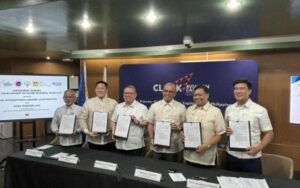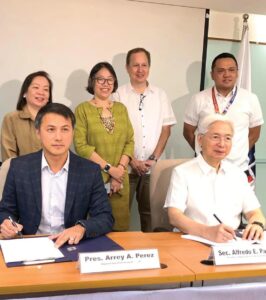In a decisive move to modernize the Philippines’ agricultural supply chain and secure long-term food security, the government has launched a flagship infrastructure project. The Food Terminal Inc. (FTI) and the Clark International Airport Corp. (CIAC) have officially sealed a partnership to establish the PHP3.6-billion Bagsakan ng Bayan Mega Food Hub (BBM Food Hub) within the sprawling economic zone of Clark, Pampanga. This ambitious endeavor is poised to transform how agricultural products are traded, processed, and distributed across Northern Luzon and beyond.
The landmark agreement, formalized through a Memorandum of Agreement (MOA), was signed by FTI President Joseph Lo and CIAC President Joseph Alcazar. The significance of the initiative was underscored by the presence of Department of Agriculture (DA) Secretary Francisco Tiu Laurel Jr., who witnessed the signing ceremony at the Bases Conversion and Development Authority (BCDA) office in Taguig City. This collaboration between two key government-owned and controlled corporations (GOCCs) signals a unified commitment to executing the administration’s vision for a robust, efficient, and equitable food system.

🗺️ A Strategic Lease for a National Necessity
Under the terms of the MOA, FTI will secure a 25-year lease on the strategic Clark property from CIAC. This long-term commitment provides the necessary foundation for FTI to develop, operate, and maintain a massive, integrated agri-food complex designed not only to handle high volumes of produce but also to stabilize market prices and significantly improve the income of Filipino farmers and fisherfolk.
Secretary Tiu Laurel Jr. highlighted the project as a critical pillar of the DA’s comprehensive, long-term strategy to bring the country’s food supply chain up to global standards. He pointed to successful, large-scale trading and distribution centers in neighboring Asian countries, such as Thailand, as the aspirational model for the BBM Food Hub.
“This investment is not merely about building structures; it’s about constructing a foundation for national resilience,” stated Secretary Tiu Laurel. “This is one of several mega food hubs the DA is committed to developing to ensure stable markets and long-term food security for our growing population. It directly supports the vision of President Ferdinand R. Marcos Jr. of giving farmers and fisherfolk fair access to markets through strategically located food terminals that cut out unnecessary intermediaries.”
The rationale behind the Clark location is compelling. Situated in a rapidly developing logistics and transport corridor, the hub will capitalize on accessibility to major expressways and the Clark International Airport, facilitating both domestic and international trade opportunities for high-value agricultural commodities.
🍎 The Architecture of an Integrated Agri-Food Ecosystem
The envisioned 46-hectare complex is designed to be the definitive Northern Luzon food trading and logistics center. It represents a holistic approach, integrating multiple essential components that are currently fragmented across the region:
Wholesale Trading Facility: A modernized market area that can accommodate thousands of transactions daily, ensuring transparency and efficiency in bulk trading.
Advanced Cold Storage and Warehousing: Crucial infrastructure equipped with modern temperature-controlled facilities to drastically reduce post-harvest losses, which currently amount to billions of pesos annually. This extends the shelf life of perishable goods and ensures a consistent supply year-round.
Food Processing Hub: Dedicated zones for value-adding activities, including packaging, sorting, and primary processing. This encourages local entrepreneurs to transform raw produce into higher-margin products before they hit the retail market.
Logistics and Distribution Center: State-of-the-art systems to manage inbound and outbound supply chains, optimizing transport routes and minimizing delays.
Agri-Tourism Facilities: Spaces designed to educate the public on modern agriculture and connect consumers directly with producers, fostering a greater appreciation for the food journey.
🌾 Promoting Inclusivity and Modernization
In a key effort to support local livelihoods and cater to diverse market needs, the BBM Food Hub will incorporate specialized features:
Halal-Certified Zone: A dedicated area designed and certified to handle and process Halal food products, opening doors to expanded trade with Muslim communities and international markets in the Middle East and Southeast Asia.
One Town, One Product (OTOP) Enterprise Spaces: These dedicated areas will provide provincial micro, small, and medium enterprises (MSMEs) with a prime, high-traffic commercial location to showcase and sell their specialized regional products, promoting local innovation and economic growth outside traditional metropolitan centers.
According to the DA’s timeline, FTI is slated to commence the initial development of a 10-hectare section of the Clark hub early next year, signaling the immediate prioritization of the project.
💰 Reviving a Core Mission and Ensuring Fair Play
FTI President Joseph Lo emphasized that this project represents a powerful revival of FTI’s original, foundational mission. That mission was to bypass layers of middlemen by linking farmers directly to consumers—a connection that is vital for achieving both fair farm-gate prices and reasonable consumer costs.
Lo detailed the multifaceted economic benefits anticipated from the hub:
“The Bagsakan ng Bayan Mega Food Hub will act as a powerful magnet, drawing in producers and agricultural entrepreneurs from across Northern Luzon,” Lo explained. “By providing a centralized, efficient, and transparent market, we will ensure fair farm-gate prices for our hardworking producers, which in turn will translate into lower food costs for urban consumers. Crucially, the modernization of logistics and storage will dramatically reduce wastage, a persistent national problem. Furthermore, this massive operation will create thousands of new jobs in the agri-logistics sector and, perhaps most importantly, provide the structural backbone necessary to stabilize the nation’s food supply against external shocks and internal challenges.”
📈 Blueprint for a National Network

The Clark BBM Food Hub is not an isolated project; it serves as the initial cornerstone of a larger, national mega food hub network. The government has already laid out plans for two additional, strategically located facilities to complete the national grid:
-
Mindanao Hub: A 40-hectare facility planned for Bukidnon, which is known as the food basket of Mindanao. This hub will solidify the distribution of tropical fruits, corn, and livestock products from the south.
Southern Luzon and Bicol Region Hub: A 30-hectare complex earmarked for Quezon province, perfectly situated to manage the flow of coconut products, vegetables, and fish to the densely populated National Capital Region and across Southern Luzon and the Bicol Region.
By establishing these strategic hubs, the Philippines aims to transition its food system from a fragmented, vulnerable collection of local markets to a resilient, integrated national supply chain. This strategic infrastructure investment is set to be one of the most critical steps taken by the current administration to ensure that modern agriculture becomes the engine of inclusive economic growth and a permanent guarantor of national food security.




